教师结构化面试题答案(含英文翻译)
英语教师面试:结构化问题与答案
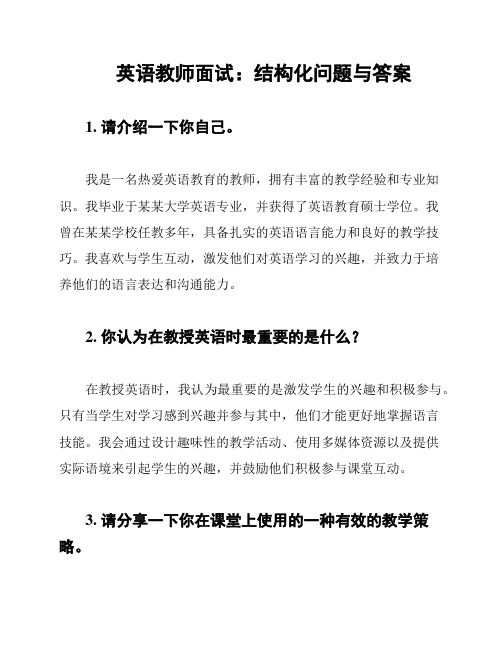
英语教师面试:结构化问题与答案1. 请介绍一下你自己。
我是一名热爱英语教育的教师,拥有丰富的教学经验和专业知识。
我毕业于某某大学英语专业,并获得了英语教育硕士学位。
我曾在某某学校任教多年,具备扎实的英语语言能力和良好的教学技巧。
我喜欢与学生互动,激发他们对英语学习的兴趣,并致力于培养他们的语言表达和沟通能力。
2. 你认为在教授英语时最重要的是什么?在教授英语时,我认为最重要的是激发学生的兴趣和积极参与。
只有当学生对学习感到兴趣并参与其中,他们才能更好地掌握语言技能。
我会通过设计趣味性的教学活动、使用多媒体资源以及提供实际语境来引起学生的兴趣,并鼓励他们积极参与课堂互动。
3. 请分享一下你在课堂上使用的一种有效的教学策略。
在课堂上,我经常使用互动式教学策略。
我鼓励学生之间的合作和交流,使他们能够在真实的语言环境中运用所学的知识。
例如,我会组织小组讨论、角色扮演、游戏等活动,让学生主动参与并运用英语进行交流。
通过这种方式,学生能够更好地理解和掌握英语,并提高他们的口语表达能力。
4. 你如何评估学生的英语水平和学习进展?评估学生的英语水平和学习进展是非常重要的,我会使用多种评估方法。
除了正式的考试和测验外,我还会定期进行口语和听力测试,观察学生的写作和阅读能力,并通过课堂表现和作业质量来评估他们的学习进展。
我也会与学生和家长进行沟通,了解他们对英语学习的感受和意见,以便调整教学方法和内容,帮助学生更好地提高。
5. 请描述一次你成功激励学生的经历。
在过去的一次教学中,我遇到了一个学习英语较为 passively 的学生。
为了激励他,我设计了一堂有趣的课程,以他感兴趣的主题为基础。
我使用了一些互动的教学方法,如游戏和小组讨论,让他参与到课堂活动中。
通过这种方式,他开始积极主动地参与课堂讨论,并展示了他的英语能力。
这次经历让我意识到,激发学生的兴趣和参与是提高他们学习动力的关键。
以上是我对于英语教师面试中结构化问题的回答,希望能对您有所帮助。
英语教师招聘面试题目(3篇)

第1篇1. 你教了几年书?How long have you been teaching?参考答案:I have been teaching for [具体年数] years. I have gained a wealth of experience in teaching English to students of different ages and levels.2. 有教小学的经验吗?Did you have any experiences teaching in elementary school?参考答案:Yes, I have. I have been teaching in elementary schools for [具体年数] years. I am familiar with the curriculum and teaching methods suitable for young students.3. 为什么要选择教师这个行业?Why did you choose to become a teacher?参考答案:I have always been passionate about teaching and helping students learn. I believe that education is the key to success and personal growth. As a teacher, I can make a positive impact on students' lives and help them achieve their full potential.4. 你如何看待教师这个工作?How do you see the job of a teacher?参考答案:I see teaching as a noble profession that requires dedication, patience, and creativity. A teacher is not only a mentor but also a guide who inspires and motivates students to learn and excel.5. 你认为一个优秀的英语教师应该具备哪些素质?What qualities do you thinka good English teacher should have?参考答案:An excellent English teacher should possess strong communication skills, patience, creativity, and a passion for teaching. They should be knowledgeable about the English language and have the ability to adapt their teaching methods to cater to the needs of diverse students.6. 你在课堂上如何激发学生的学习兴趣?How do you engage students in your lessons?参考答案:I believe in creating a positive and interactive learning environment. I use a variety of teaching methods, such as games, songs, and group activities, to make the learning process enjoyable and engaging. I also encourage students to participate in discussions and share their thoughts.7. 你如何评估学生的学习成果?How do you assess students' learning outcomes?参考答案:I use a combination of formative and summative assessments to evaluate students' progress. This includes quizzes, tests, homework, and oral presentations. I also provide feedback and guidance to helpstudents improve their skills.8. 你在面试中有什么问题要问我们吗?Do you have any questions for us?参考答案:Yes, I would like to know more about the teaching philosophyof the school and the expectations for English teachers in this position.以上是一些常见的英语教师招聘面试问题及其参考答案。
结构化英语教师面试问题与解答
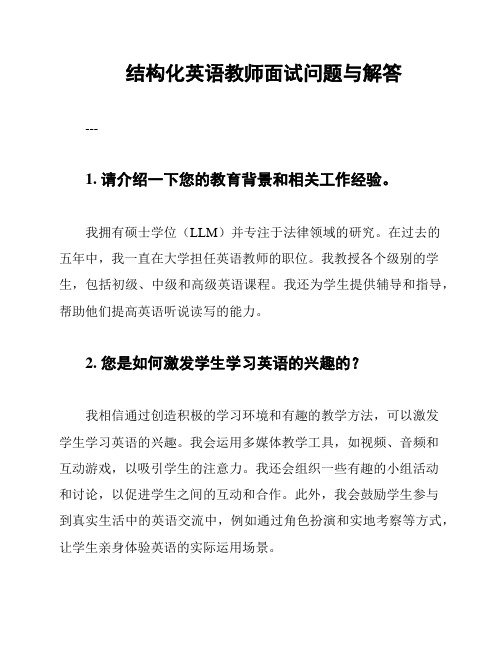
结构化英语教师面试问题与解答---1. 请介绍一下您的教育背景和相关工作经验。
我拥有硕士学位(LLM)并专注于法律领域的研究。
在过去的五年中,我一直在大学担任英语教师的职位。
我教授各个级别的学生,包括初级、中级和高级英语课程。
我还为学生提供辅导和指导,帮助他们提高英语听说读写的能力。
2. 您是如何激发学生学习英语的兴趣的?我相信通过创造积极的学习环境和有趣的教学方法,可以激发学生学习英语的兴趣。
我会运用多媒体教学工具,如视频、音频和互动游戏,以吸引学生的注意力。
我还会组织一些有趣的小组活动和讨论,以促进学生之间的互动和合作。
此外,我会鼓励学生参与到真实生活中的英语交流中,例如通过角色扮演和实地考察等方式,让学生亲身体验英语的实际运用场景。
3. 您如何评估学生的英语水平和进步情况?我会采用多种评估方法来评估学生的英语水平和进步情况。
除了定期的听说读写测试,我还会观察学生在课堂上的表现和参与度。
我会密切关注学生的口语表达能力、词汇量和语法运用等方面,并提供针对性的反馈和建议。
此外,我还会鼓励学生参加英语角、演讲比赛和写作竞赛等活动,以展示他们的英语技能和进步情况。
4. 您在教学中遇到的最大挑战是什么?您是如何应对的?在教学中,我遇到的最大挑战之一是学生的不同学习能力和兴趣水平。
为了应对这一挑战,我会采用不同的教学策略和方法,以满足每个学生的需求。
我会根据学生的英语水平和学习风格,灵活调整教学内容和难度,并提供个性化的辅导和指导。
此外,我还会鼓励学生之间的互助学习和合作,通过小组活动和讨论等方式促进学生之间的相互学习和成长。
5. 您认为什么是成功的英语教学的关键因素?成功的英语教学的关键因素之一是激发学生学习英语的兴趣和动力。
一个积极的学习环境和有趣的教学方法可以帮助学生更好地投入学习,并保持持续的学习动力。
另一个关键因素是提供个性化的教学和辅导。
每个学生都有不同的学习需求和学习方式,因此教师需要根据学生的特点和需求,灵活调整教学策略和方法,以促进每个学生的学习进步。
结构化面试:英语教师试题与答案
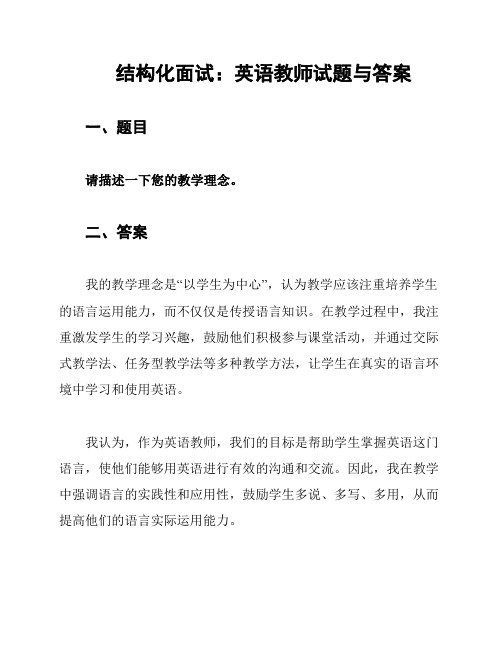
结构化面试:英语教师试题与答案一、题目请描述一下您的教学理念。
二、答案我的教学理念是“以学生为中心”,认为教学应该注重培养学生的语言运用能力,而不仅仅是传授语言知识。
在教学过程中,我注重激发学生的学习兴趣,鼓励他们积极参与课堂活动,并通过交际式教学法、任务型教学法等多种教学方法,让学生在真实的语言环境中学习和使用英语。
我认为,作为英语教师,我们的目标是帮助学生掌握英语这门语言,使他们能够用英语进行有效的沟通和交流。
因此,我在教学中强调语言的实践性和应用性,鼓励学生多说、多写、多用,从而提高他们的语言实际运用能力。
此外,我也非常注重个性化教学,认为每个学生都有自己的学习特点和需求,因此在教学过程中,我会根据学生的实际情况进行调整,以满足他们的个性化学习需求。
总的来说,我的教学理念是以学生为中心,注重培养学生的语言运用能力,通过多种教学方法和个性化教学,帮助学生掌握英语,提高他们的语言实际运用能力。
---一、题目请介绍一下您在课堂教学中使用的主要教学方法。
二、答案在课堂教学中,我主要使用以下几种教学方法:2. 任务型教学法(Task-Based Language Teaching):这种教学方法以任务为核心,让学生在完成各种真实任务的过程中学习和使用语言。
任务可以是小组项目、报告、解决问题的活动等,旨在培养学生的综合语言运用能力。
3. 全身反应法(Total Physical Response):这种教学方法通过身体动作来教授语言,让学生通过身体动作来理解和表达语言,特别适合于动词和动词短语的教学。
4. 合作学习法(Cooperative Learning):这种教学方法强调学生之间的合作和互助,通过小组活动、同伴教学等形式,培养学生的团队合作能力和社交技能。
5. 信息技术辅助教学法:在课堂教学中,我会使用多媒体、网络等信息技术手段,为学生提供丰富的学习资源和真实的语言环境,提高教学效果。
以上是我主要使用的教学方法,我会根据学生的实际情况和教学目标,灵活运用和调整,以满足学生的学习需求。
英语教师面试:结构化问题与答案

英语教师面试:结构化问题与答案个人和教育背景
问题:请简要介绍一下您的个人和教育背景。
{content}
教学经验和方法
问题:请谈谈您以往的教学经验和教学方法。
{content}
对英语教学的理解
问题:您如何看待英语教学?请谈谈您的教学理念。
{content}
教学目标和计划
问题:如果让您负责一个英语教学项目,您会如何设定教学目标和制定教学计划?
{content}
学生管理和纪律
问题:在课堂上,您如何管理和维护学生纪律?
{content}
评估和反馈
问题:您如何评估学生的学习成果?请谈谈您给予学生反馈的方式。
{content}
继续教育和自我提升
问题:您如何看待继续教育和自我提升?请谈谈您在教学之余进行的学术研究或专业发展。
{content}
应对挑战和困难
问题:在教学过程中,您可能会遇到各种挑战和困难。
请举例说明您是如何应对这些挑战和困难的。
{content}
团队合作和交流
问题:您如何看待团队合作和交流?请谈谈您在与同事、学生和家长沟通合作时的经验。
{content}
总结
通过以上问题的回答,我们可以了解到面试者的个人背景、教学经验、教育理念、应对挑战的能力以及团队合作交流等方面的情况。
这些信息对于评估面试者是否符合英语教师岗位的要求具有重要意义。
希望这份面试指南对您有所帮助。
教师资格考试初中面试英语试题与参考答案
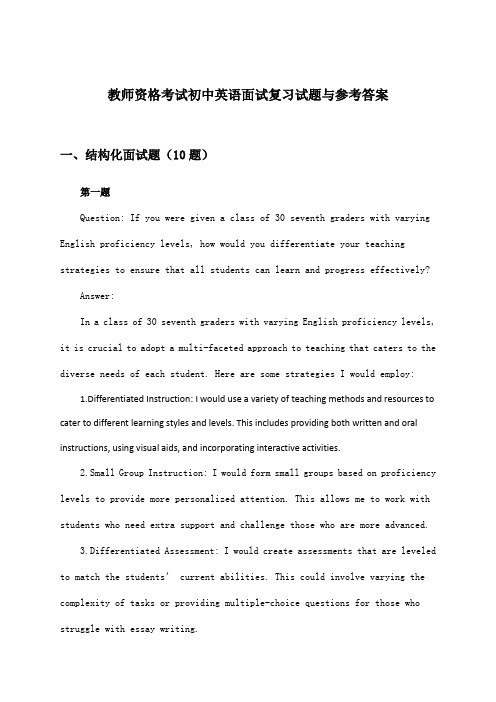
教师资格考试初中英语面试复习试题与参考答案一、结构化面试题(10题)第一题Question: If you were given a class of 30 seventh graders with varying English proficiency levels, how would you differentiate your teaching strategies to ensure that all students can learn and progress effectively?Answer:In a class of 30 seventh graders with varying English proficiency levels, it is crucial to adopt a multi-faceted approach to teaching that caters to the diverse needs of each student. Here are some strategies I would employ:1.Differentiated Instruction: I would use a variety of teaching methods and resources to cater to different learning styles and levels. This includes providing both written and oral instructions, using visual aids, and incorporating interactive activities.2.Small Group Instruction: I would form small groups based on proficiency levels to provide more personalized attention. This allows me to work with students who need extra support and challenge those who are more advanced.3.Differentiated Assessment: I would create assessments that are leveled to match the students’ current abilities. This could involve varying the complexity of tasks or providing multiple-choice questions for those who struggle with essay writing.nguage Support: For students who are still developing their English language skills, I would incorporate language support strategies such as using simplified language, providing glossaries, and using gestures and body language to aid comprehension.5.Encouragement and Motivation: I would make sure to praise and encourage all students, recognizing their efforts and progress. Motivation is key to keeping all students engaged and committed to learning.6.Differentiated Homework: I would assign homework that is appropriate for each student’s level, ensuring that it i s neither too easy nor too difficult. This could involve extension activities for more advanced students and review exercises for those who need extra practice.Explanation:Differentiated instruction is essential in a classroom with diverse learners. By implementing a variety of strategies, I aim to provide an inclusive learning environment where each student feels valued and supported. The focus is on meeting students where they are and helping them to reach their full potential in English language learning.第二题Question:How would you effectively differentiate instruction in your middle school English classroom to cater to the diverse learning styles, abilities, and backgrounds of your students?Answer:In my middle school English classroom, I would employ a variety of strategies to differentiate instruction that accommodate different learning styles, abilities, and backgrounds. Here’s how I would approach this:1.Assessment for Learning: Before planning lessons, I would conduct formative assessments to understand each student’s strengths, weaknesses, and preferred learning modalities. This could include reading comprehension quizzes, writing samples, or speaking and listening exercises.2.Flexible Grouping: I would use flexible grouping techniques, such as mixed-ability or interest-based groups, to create an inclusive learning environment. This allows students to work together, collaborate, and learn from one another.3.Adaptive Instruction: For students with varying abilities, I would provide modified assignments and support. For example, I could offer simpler versions of reading materials for struggling readers or more challenging texts for advanced learners.4.Visual and Auditory Aids: To cater to visual and auditory learners, I would incorporate multimedia resources, such as videos, interactive presentations, and audio recordings, into my lessons.5.Hands-On Activities: For kinesthetic learners, I would incorporate hands-on activities, such as role-playing, group projects, and interactive games, to engage their physical movement and reinforce learning.6.Cultural Responsiveness: Recognizing the diverse backgrounds of mystudents, I would incorporate culturally relevant materials and themes into my teaching. This includes using literature that reflects the experiences and perspectives of various cultures.7.Differentiated Homework: I would assign differentiated homework that allows students to demonstrate their understanding in various ways. Some students might complete a written assignment, while others might create a presentation, a podcast, or a visual representation of the lesson.8.Feedback and Support: I would provide timely and specific feedback to each student, highlighting their strengths and suggesting areas for improvement. Additionally, I would offer support through tutoring sessions or one-on-one conferences.Explanation:Differentiation in the classroom is crucial because it ensures that all students have the opportunity to learn and succeed. By using a combination of these strategies, I can create a dynamic and responsive learning environment that addresses the unique needs of each student. This approach not only enhances student engagement but also fosters a sense of belonging and inclusivity within the classroom.第三题Question: As an English teacher for junior high school, how would you differentiate your teaching methods for students with different learning styles (e.g., auditory, visual, kinesthetic)?Answer:In response to the diverse learning styles of students, I would implement a multifaceted teaching approach that caters to auditory, visual, and kinesthetic learners. Here’s a breakdown of my strategies for each type of learner:1.Auditory Learners:•Incorporate songs, rhymes, and chants into the lessons to reinforce vocabulary and grammar.•Use storytelling techniques to engage students in the narrative, thereby enhancing their listening skills.•Facilitate discussions and group activities that encourage speaking and listening, such as debates or role-playing exercises.2.Visual Learners:•Create visual aids like flashcards, diagrams, and posters to illustrate concepts and vocabulary.•Utilize multimedia resources, such as videos and slideshows, to present information in a visually engaging manner.•Design interactive whiteboards or use projectors to display key points during lessons, allowing students to follow along visually.3.Kinesthetic Learners:•Introduce activities that require physical movement, like “Simon Says”games for vocabulary practice or “Simon Says” for gr ammar exercises.•Encourage students to engage in hands-on projects, such as creating theirown booklets or posters to showcase their understanding of the lesson material.•Use role-playing and simulations to provide kinesthetic learners with a concrete context in which to apply their language skills.By incorporating these diverse teaching methods, I aim to provide a comprehensive learning experience that caters to the varying needs of my students. Additionally, I would continually assess their progress and adjust my strategies as needed to ensure that each student has the opportunity to succeed.Explanation:The answer provided above outlines a comprehensive approach to catering to the different learning styles of students in a junior high school English classroom. It emphasizes the importance of incorporating a variety of teaching methods to engage students with different learning preferences. By addressing auditory, visual, and kinesthetic learners, the teacher demonstrates a commitment to creating an inclusive and supportive learning environment. The explanation provides a rationale for each teaching strategy, highlighting the benefits of using these methods for each type of learner.第四题Question: How would you handle a situation where a student in your class has a strong negative attitude towards learning English, and this attitude is affecting their performance and the class dynamic?Answer:1.Initial Assessment: First, I would observe the student’s behavior and interactionswithin the classroom to understand the root cause of their negative attitude. It’s essential to gather information from various sources such as the student, their peers, and their parents.2.One-on-One Conversation: I would initiate a private conversation with the student to express concern for their well-being and to discuss their feelings about learning English. This allows the student to feel valued and understood.3.Encourage Openness and Empathy: During the conversation, I would encourage the student to share their thoughts and feelings without fear of judgment. I would listen actively and show empathy to build a rapport.4.Identify Challenges: We would identify the specific challenges the student is facing, whether they are related to the curriculum, learning style, peer pressure, or personal issues.5.Tailor Instruction: Based on the identified challenges, I would adapt my teaching methods to better suit the student’s needs. This could include using different resources, adjusting the pace of learning, or incorporating student interests into lesson plans.6.Peer Support: I would encourage positive peer interaction by forming study groups or peer tutoring sessions where students can support each other.7.Positive Reinforcement: I would use positive reinforcement techniques to acknowledge the student’s effort s and progress, regardless of the outcomes, to build their confidence.8.Collaborate with Parents and Guardians: I would involve the student’s parents or guardians in the process to provide additional support and to ensure consistency between home and school.9.Regular Check-ins: I would schedule regular check-ins with the student to monitor their progress and adjust strategies as necessary.10.Professional Development: If the issue persists, I would seek guidance from colleagues, mentors, or professional development resources to refine my approach.Explanation:The key to handling such a situation is to approach it with patience, understanding, and a commitment to the student’s growth. By understanding the underlying reasons for the negative attitude, tailoring the learning experience, and fostering a supportive environment, it is possible to turn around a student’s attitude and improve their performance and the class dynamic. It’s also important to maintain open communication channels with all stakeholders to ensure a holistic approach to the student’s education.第五题Question:As an English teacher for junior high school students, how would you differentiate your teaching methods to cater to students with diverse learning styles, such as visual, auditory, and kinesthetic learners?Answer:As an English teacher aiming to cater to students with diverse learning styles, I would adopt a multifaceted approach that integrates various teaching methods to engage all types of learners. Here’s how I would differentiate myteaching for visual, auditory, and kinesthetic learners:1.Visual Learners:•Use visual aids such as flashcards, posters, and diagrams to illustrate vocabulary and grammar points.•Create presentations and videos that include visual examples of language use in real-world contexts.•Encourage students to create their own visual summaries of texts or stories they have read.2.Auditory Learners:•Incorporate songs, poems, and dialogues into lessons to reinforce language learning through listening.•Conduct discussions and group activities where students can engage in verbal interactions.•Use storytelling and role-plays to help auditory learners absorb and remember the language.3.Kinesthetic Learners:•Design activities that involve physical movement, such as “Simon Says”games or theater exercises to practice language.•Incorporate hands-on activities like making models or dioramas to represent stories or concepts.•Encourage kinesthetic learners to act out scenes or use puppets to express their understanding of the material.Explanation:Differentiating instruction is essential to ensure that all students have the opportunity to learn effectively. By recognizing and addressing the specific needs of visual, auditory, and kinesthetic learners, I can create a classroom environment that caters to their preferences and strengths. This approach not only helps to engage all students but also enhances their overall language acquisition and retention. Additionally, it fosters a more inclusive classroom where students feel valued and understood, leading to higher levels of motivation and success.第六题Question:If you were teaching a group of初中 students who were struggling with understanding the past perfect tense, how would you adapt your teaching methods to ensure they grasp the concept effectively?Answer:1.Assess Understanding: Begin by assessing the students’ current understanding of the past perfect tense through a brief quiz or discussion. This will help identify their specific areas of confusion.e Real-Life Examples: Present real-life examples that naturally incorporate the past perfect tense. For instance, you could discuss a historical event and use sentences like, “The Great Wall had been built for centuries before the tourists arrived.”3.Visual Aids: Create visual aids such as timelines or storyboards to illustrate the sequence of events that require the use of the past perfect tense.This can help students visualize the concept.4.Interactive Activities: Engage students in interactive activities such as role-playing, where they can practice using the past perfect tense in context. For example, students could act out a scenario where one person asks about another’s past experiences.5.Collaborative Learning: Pair students up or form small groups to discuss and create sentences using the past perfect tense. This encourages peer learning and can help clarify misunderstandings.6.Consistent Practice: Incorporate regular practice sessions into your lessons, where students can practice forming and using past perfect tense sentences. This could include completing worksheets, online exercises, or oral drills.7.Differentiated Instruction: Recognize that students have different learning styles. Offer alternative methods such as video tutorials, audio recordings, or written explanations for those who may need additional support.8.Feedback and Adjustment: Provide immediate feedback on students’ usage of the past perfect tense and be prepared to adjust your teaching methods based on their progress and feedback.Explanation:The key to teaching the past perfect tense effectively to struggling students lies in making the concept relatable and accessible. By using real-life examples, visual aids, and interactive activities, students can engage with the materialin a way that resonates with them. Additionally, by offering a variety of teaching methods and allowing for collaborative learning, students can learn from each other and reinforce their understanding. Regular practice and personalized feedback ensure that each student receives the support they need to master the concept.第七题Question:Discuss the importance of integrating technology in teaching English to junior high school students and provide an example of how you would use technology in your classroom.Answer:Integrating technology into the teaching of English to junior high school students is essential for several reasons. Firstly, it enhances student engagement by providing interactive and dynamic learning experiences that can cater to different learning styles. Secondly, technology facilitates access to a vast array of resources, such as authentic materials from English-speaking countries, which can improve students’ language skills and cultural understanding. Additionally, using technology can help prepare students for a digital world where online communication and digital literacy are increasingly important.For example, I could incorporate a video project into my lesson plan where students work in groups to create short films or presentations on topics relatedto the curriculum. They would be required to research their topic, write scripts, record videos, and edit them using software like iMovie or Windows Movie Maker. This activity not only promotes collaborative learning and creativity but also provides practical experience with digital tools that are relevant to today’s job market. Furthermore, by sharing these projects with the class, students can practice their speaking and listening skills while receiving constructive feedback from their peers and teacher.Explanation:This question assesses the candidate’s ability to recognize the benefits of using technology in education and apply this knowledge practically. The answer provided demonstrates an understanding of how technology can enhance the learning environment and support the development of 21st-century skills. By giving a specific example of a video project, the response shows that the teacher can effectively integrate technology into the curriculum in a way that aligns with educational goals and fosters student engagement and collaboration.第八题Question: If you were teaching a class of students who had a diverse range of English proficiency levels, how would you differentiate your instruction to meet their individual needs and ensure that all students can participate effectively in the learning process?Answer:In a class with diverse English proficiency levels, I would implement thefollowing strategies to differentiate instruction and ensure effective participation from all students:1.Assessment and Grouping: Start by assessing the students’ current English proficiency levels through oral and written assessments. Based on these results, I would formmixed-ability groups where students with similar proficiency levels are placed together, but also ensure that there are opportunities for collaboration across groups.nguage Simplification: For students with lower proficiency, I would simplify the language by using clear, concise sentences and vocabulary that they can understand. I would also use visual aids, gestures, and body language to complement my verbal explanations.3.Task Differentiation: Assign tasks that cater to different proficiency levels. For example, advanced students might be given more complex projects or discussions, while lower-level students could focus on simpler tasks like vocabulary practice or basic sentence structure exercises.4.Interactive and Collaborative Activities: Incorporate interactive activities that encourage collaboration and peer support. This allows students to learn from each other and build confidence in their language abilities.5.Feedback and Encouragement: Provide regular, constructive feedback that focuses on improvement rather than criticism. Encourage students to set personal goals and celebrate their progress, regardless of their proficiency level.6.Differentiated Instructional Materials: Use a variety of resources and materials that are appropriate for different levels. This might include simplified textbooks, online resources, or additional worksheets for strugglingstudents.7.Flexible Learning Environment: Create a flexible learning environment where students can work at their own pace. This could involve allowing students to choose from a range of activities or giving them additional time to complete tasks.8.Parental Involvement: Keep parents info rmed about their child’s progress and involve them in the learning process. This could include sending home activity sheets or providing suggestions for language practice at home.By implementing these strategies, I can ensure that all students in the class have the opportunity to learn and participate effectively, regardless of their initial English proficiency level.Explanation:The answer provided outlines a comprehensive approach to managing a diverse class in terms of English proficiency. It addresses the need for both formative and summative assessment to inform instruction, the importance of differentiating tasks and materials, and the role of a supportive and interactive classroom environment. Additionally, it recognizes the value of parental involv ement in supporting students’ language development outside of school.Ninth QuestionQuestion: Describe a situation where you had to adapt your teaching methodology to accommodate a student with special learning needs. What specificstrategies did you employ to ensure their inclusion and academic success?Answer Example:“In my previous teaching experience, I encountered a student who had dyslexia, which made it challenging for them to read at the same pace as their peers. To address this, I implemented several strategies to support their learning process. Firstly, I utilized audio books and text-to-speech software that helped the student engage with the material on a more accessible level. Secondly, I provided written materials well ahead of time so that they could prepare and familiarize themselves with the content. Additionally, I encouraged peer-assisted learning, pairing the student with a classmate who could assist during group activities while promoting an inclusive classroom environment. Lastly, I ensured regular one-on-one sessions to discuss any difficulties and to tailor assignments that matched their learning pace. This approach not only supported the student’s academic progress but also fostered a sense of belonging and self-esteem within the clas sroom.”Analysis:This answer demonstrates the candidate’s ability to recognize individual learning differences and implement inclusive practices. The strategies mentioned show adaptability, resourcefulness, and a commitment to creating an equitable learning environment. By outlining specific tools and methods used (audio books, text-to-speech software, advanced preparation, peer assistance, and personalized attention), the candidate illustrates practical applicationof educational theories. Moreover, the emphasis on emotional well-being and self-esteem indicates a holistic approach to education, which is crucial for supporting students with special learning needs.第十题Question:How would you handle a situation where a student in your class is consistently disruptive and disrespectful towards both the teacher and their peers?Answer:As a teacher, addressing disruptive behavior is crucial for maintaining a positive and productive learning environment. Here’s how I would handle sucha situation:1.Immediate Intervention: First and foremost, I would address the behavior immediately. I would approach the student calmly and privately, ensuring they understand that their actions are inappropriate and disruptive to the learning process.munication: I would have a conversation with the student, asking them to explain their behavior. It’s essential to listen actively and without judgment to understand the root cause of the disruption. This may involve discussing their feelings, experiences, or any external factors that might be contributing to their behavior.3.Consistent Rules and Consequences: I would remind the student of the classroom rules and the consequences of breaking them. It’s important to be consistent with the rules and the consequences to avoid confusion and reinforce the importance of respecting others.4.Behavior Contract: If the disruptive behavior continues, I would createa behavior contract with the student. This contract would outline specific expectations, goals, and the consequences of not meeting those goals. Regular check-ins and feedback would be provided to monitor progress.5.Collaboration with Parents or Guardians: In some cases, involving the student’s parents or guardians may be necessary. I would communicate with them about the student’s behavior, seek their support, and discuss strategies that can be implemented at home and school.6.Classroom Support: If the disruptive behavior affects the entire class,I would work with the students to create a supportive environment. This could involve group discussions, role-playing scenarios, or team-building activities to promote respect and cooperation among classmates.7.Professional Development: As a teacher, I would also engage in professional development opportunities to enhance my skills in dealing with disruptive behavior. This could include workshops, webinars, or seeking guidance from colleagues who have experience in this area.Explanation:It’s essential to address disruptive behavior promptly and effectively to maintain a positive learning environment. By taking a proactive approach, listening to the student, implementing consistent rules, and involving parents or guardians when necessary, teachers can help students understand the importance of respect and cooperation. Additionally, seeking professionaldevelopment opportunities ensures that teachers have the necessary tools and strategies to handle such situations effectively.二、教案设计题(3题)第一题Title:“Teaching Plan for a Junior High School English Lesson on”The Weather”Answer:Objective:1.To enable students to understand and use simple sentences to describe weather conditions.2.To enhance students’ ability to communicate in English about daily weather observations.3.To develop students’ vocabulary and grammar skills related to weather expressions.Teaching Aids:•Whiteboard and markers•Flashcards with weather-related vocabulary•Weather forecast videos or pictures•Handouts for homeworkTeaching Procedure:1.Introduction (5 minutes)•Begin the lesson by asking students to share their favorite weather and why. This will stimulate their interest and provide a context for the lesson.•Show a brief video or pictures of different weather conditions to introduce the lesson topic.2.Vocabulary Presentation (10 minutes)•Introduce new vocabulary words related to weather using flashcards. For example: sunny, cloudy, rainy, windy, stormy, etc.•Have students practice reading and pronouncing these words aloud. •Provide a brief explanation of each word and its usage in a sentence.3.Grammar Presentation (10 minutes)•Introduce the simple present tense to describe weather conditions. Use examples like “It is sunny,” “It is cloudy,” etc.•Explain the structure and usage of the simple present tense for describing weather.•Have students practice forming sentences using the simple present tense with weather words.4.Practice (15 minutes)•Divide the class into small groups and ask them to create a dialogue about weather observations using the new vocabulary and grammar. •Circulate around the classroom to provide guidance and correct any errors. •Have each group present their dialogue to the class.5.Homework Assignment (5 minutes)•Assign a homework task where students are required to write a short paragraph describing a day’s weather in their hometown using the new vocabulary andgrammar.Evaluation:•Observe students’ participation and understanding during the vocabulary and grammar presentations.•Assess students’ ability to form sentences using the simp le present tense for describing weather.•Evaluate the quality of the group dialogues and the homework assignments.Explanation:This teaching plan focuses on introducing and practicing weather-related vocabulary and grammar in a junior high school English class. By using a variety of teaching methods, such as vocabulary flashcards, grammar explanations, group work, and homework assignments, the teacher aims to provide students with a comprehensive understanding of weather-related language and enhance their communication skills. The plan is designed to be interactive and engaging, encouraging students to actively participate in the learning process.第二题题目背景: 假设您是一名初中英语教师,您的班级学生年龄在13至15岁之间,英语水平为中级。
教招面试英语试题及答案
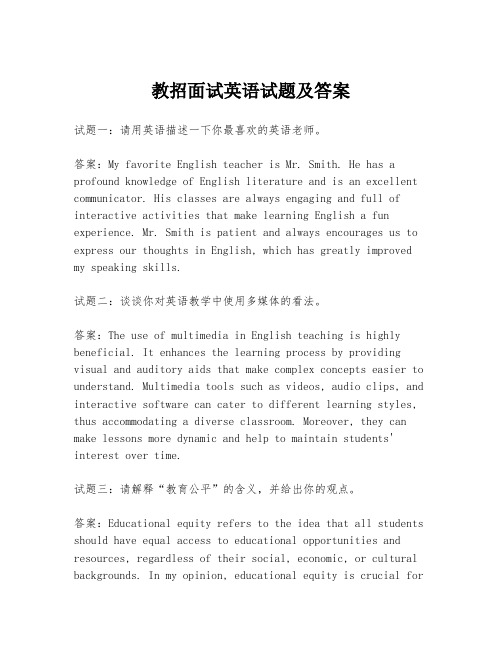
教招面试英语试题及答案试题一:请用英语描述一下你最喜欢的英语老师。
答案:My favorite English teacher is Mr. Smith. He has a profound knowledge of English literature and is an excellent communicator. His classes are always engaging and full of interactive activities that make learning English a fun experience. Mr. Smith is patient and always encourages us to express our thoughts in English, which has greatly improved my speaking skills.试题二:谈谈你对英语教学中使用多媒体的看法。
答案:The use of multimedia in English teaching is highly beneficial. It enhances the learning process by providing visual and auditory aids that make complex concepts easier to understand. Multimedia tools such as videos, audio clips, and interactive software can cater to different learning styles, thus accommodating a diverse classroom. Moreover, they can make lessons more dynamic and help to maintain students' interest over time.试题三:请解释“教育公平”的含义,并给出你的观点。
高中英语教师资格考试面试试题及解答参考(2024年)
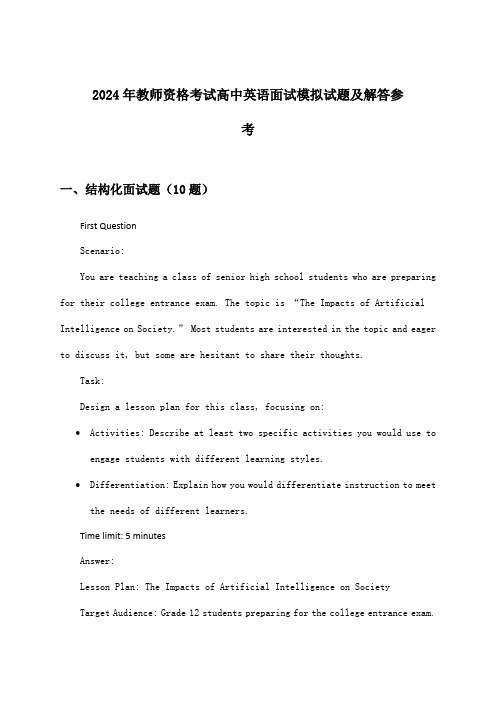
2024年教师资格考试高中英语面试模拟试题及解答参考一、结构化面试题(10题)First QuestionScenario:You are teaching a class of senior high school students who are preparing for their college entrance exam. The topic is “The Impacts of Artificial Intelligence on Society.” Most students are interested in the topic and eager to discuss it, but some are hesitant to share their thoughts.Task:Design a lesson plan for this class, focusing on:•Activities: Describe at least two specific activities you would use to engage students with different learning styles.•Differentiation: Explain how you would differentiate instruction to meet the needs of different learners.Time limit: 5 minutesAnswer:Lesson Plan: The Impacts of Artificial Intelligence on SocietyTarget Audience: Grade 12 students preparing for the college entrance exam.Learning Objectives: By the end of the lesson, students will be able to: •Identify the main impacts of AI on society, both positive and negative.•Analyze the ethical implications of AI development and deployment.•Communicate their perspectives on AI in a clear and concise manner.Activities:1.Debate: To engage students in active discussion and encourage diverse perspectives, I would divide the class into two teams – “Pro-AI” and “Anti-AI.” Each team would prepare arguments for their assigned stance based on various aspects like job displacement, privacy concerns, and advancements in healthcare. The debate format allows for structured argumentation and encourages critical thinking.2.Creative Writing: To cater to students who learn better through creative expression, I would assign them a writing prompt related to the theme. For example, “Imagine a future where AI has become deeply integrated into our daily lives. Describe a typical day in this world.” This a ctivity allows for personal reflection and exploration of the topic in a less confrontational way.Differentiation:•Content:I would provide supplemental reading materials with varying levels of complexity to cater to different reading abilities. For advanced learners, I would include articles discussing the philosophical implications of AI.•Process:For students who struggle with public speaking, I would offer the option to submit their arguments for the debate in writing.•Product:Students could choose to express their understanding through different mediums like creating a video essay, designing a poster, or writing a short story.By incorporating these activities and differentiation strategies, I aim to create a stimulating and inclusive learning environment that encourages active participation and deeper understanding of the complex topic of artificial intelligence.第二题答案:我认为在英语教育中融入文化意识至关重要。
英语教师的面试问题答案与结构

英语教师的面试问题答案与结构面试问题与答案1. 个人介绍问题: Please introduce yourself.答案:- 姓名:John/Jane Doe- 教育背景:本科/硕士/博士,主修英语教育/语言学/文学- 教学经验:X年教学经验,教授各级别学生,如小学生/初中生/高中生/成人- 教学理念:注重学生个体差异,鼓励互动与参与,提高学生的英语实际应用能力- 其他:对英语教育事业的热爱,积极参与专业发展,如参加教育培训、研讨会等2. 教学方法与技巧问题: How do you handle a large class?答案:- 建立课堂规则,确保课堂秩序- 采取小组教学,增加学生互动- 利用多媒体教学资源,吸引学生注意力- 定期进行课堂评估,关注学生的学习进度3. 课堂管理问题: How do you deal with a disruptive student?答案:- 保持冷静,以尊重的态度与学生沟通- 了解学生行为背后的原因,提供适当的支持与指导- 与学生建立信任关系,鼓励其遵守课堂规则- 采取正面激励措施,如表扬表现良好的学生4. 课程设计问题: How do you design a lesson plan?答案:- 分析学生的学习需求和兴趣,确定教学目标- 选择适当的教学内容,如词汇、语法、听力和口语练习- 设计多样的教学活动,如小组讨论、角色扮演、游戏等- 评估学生的学习成果,调整教学方法和内容5. 评估与反馈问题: How do you give feedback to students?答案:- 提供具体的、建设性的反馈,指出学生的优点和需要改进的地方- 鼓励学生自主反思,激发其自我改进的动力- 使用多种评估方式,如课堂表现、作业、测验和考试等- 与学生定期沟通,关注其学习进展和困惑6. 专业发展问题: How do you keep your teaching skills up-to-date?答案:- 参加教育培训、研讨会和工作坊,学习新的教学方法和技巧- 阅读专业书籍、期刊,了解最新的英语教育研究- 与同事交流经验,分享教学心得和困惑- 不断反思和评估自己的教学实践,寻求改进的空间总结以上是针对英语教师面试常见问题的答案与结构,希望对您有所帮助。
2024年教师资格考试初级中学面试英语试题及解答参考
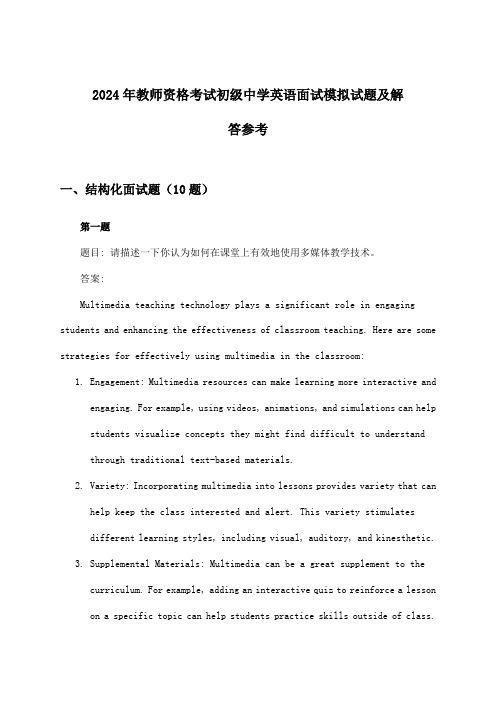
2024年教师资格考试初级中学英语面试模拟试题及解答参考一、结构化面试题(10题)第一题题目: 请描述一下你认为如何在课堂上有效地使用多媒体教学技术。
答案:Multimedia teaching technology plays a significant role in engaging students and enhancing the effectiveness of classroom teaching. Here are some strategies for effectively using multimedia in the classroom:1.Engagement: Multimedia resources can make learning more interactive andengaging. For example, using videos, animations, and simulations can help students visualize concepts they might find difficult to understandthrough traditional text-based materials.2.Variety: Incorporating multimedia into lessons provides variety that canhelp keep the class interested and alert. This variety stimulatesdifferent learning styles, including visual, auditory, and kinesthetic.3.Supplemental Materials: Multimedia can be a great supplement to thecurriculum. For example, adding an interactive quiz to reinforce a lesson on a specific topic can help students practice skills outside of class.4.Pedagogical Purpose: Always have a clear educational purpose in mind whenusing multimedia. It should not just be an addition for the sake of being modern; rather, it should support the learning objectives of the lesson.5.Technology Accessibility: Ensure that all students have equal access tomultimedia resources. This may involve preparing alternative versions of multimedia content or providing reliable access to technology for all students.6.Quality Control: Pay attention to the quality of multimedia materials used.Low-quality content can detract from the learning experience. It’simportant to select content that is accurate, appropriate, and engaging.解析:This question assesses the candidate’s understanding and application of modern educational technology in the classroom. The answer provided outlines how multimedia can enhance teaching and learning, emphasizing its role in making content more engaging and accessible to a variety of learning styles. It also touches on the importance of ensuring all students have access to multimedia resources and the need for quality control.To effectively answer this question, a candidate should demonstrate an understanding of how technology can be integrated into the curriculum to support teaching objectives and student learning. Candidates should also consider the practical aspects of integrating multimedia, such as ensuring access to technology and selecting high-quality resources.第二题题目:你是一名初中英语教师,你的学生在学习一篇关于环境保护的文章时感到困惑和沮丧,因为他们无法理解复杂的词汇和句型。
2025年教师资格考试高中面试英语试题及解答参考
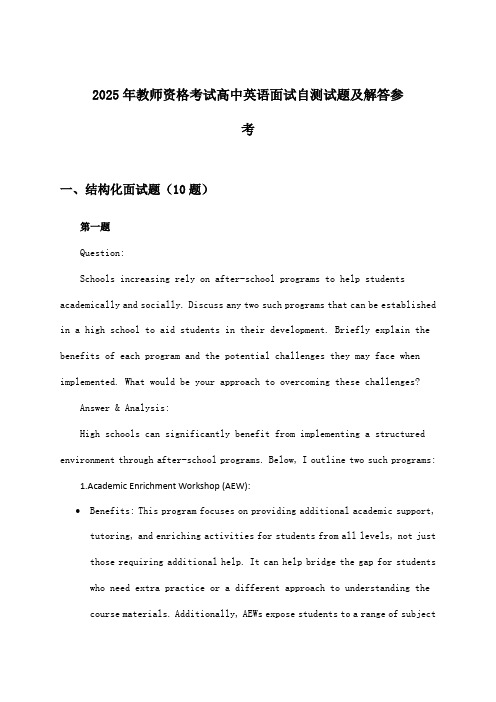
2025年教师资格考试高中英语面试自测试题及解答参考一、结构化面试题(10题)第一题Question:Schools increasing rely on after-school programs to help students academically and socially. Discuss any two such programs that can be established in a high school to aid students in their development. Briefly explain the benefits of each program and the potential challenges they may face when implemented. What would be your approach to overcoming these challenges?Answer & Analysis:High schools can significantly benefit from implementing a structured environment through after-school programs. Below, I outline two such programs:1.Academic Enrichment Workshop (AEW):•Benefits: This program focuses on providing additional academic support, tutoring, and enriching activities for students from all levels, not just those requiring additional help. It can help bridge the gap for students who need extra practice or a different approach to understanding the course materials. Additionally, AEWs expose students to a range of subjectareas, fostering broad intellectual development and promoting a lifelong love of learning.•Challenges: One major challenge is ensuring that the program is staffed with qualified, enthusiastic, and effective teachers who can motivate and engage the students beyond the standard classroom hours. There’s also the risk of a widening achievement gap for advanced students, as their needs might not be adequately met within the one-size-fits-all structure. •Approach to Challenges: To address the staffing issue, hiring current teachers with varying expertise on a reimbursable basis or lyceum arrangement could provide the needed flexibility. Additionally,involving parents and students in the program’s design ensures it caters to real needs. Regular monitoring and adapting the program components can keep up with diverse academic risks.2.Social and Emotional Learning (SEL) Workshops:•Benefits: SEL programs aim to nurture and enhance students’ social and emotional skills, including self-awareness, self-management, social skills, and responsible decision-making. These skills contribute to the students’ over all well-being, could support better mental health outcomes, and improve school climate, which is crucial for learning and engagement.•Challenges: Implementing such programs can be resource-intensive, needing trained professionals and, sometimes, specialized space.Additionally, integrating SEL with the core curriculum can be challenging without disrupting the existing academic schedule.•Approach to Challenges: Integrating with existing structures, perhaps within interdisciplinary classes or as a separate period, can confuse its relative importance while considering practicalities. To ensure broad involvement, bringing the program into the public realm with workshops and seminars for parents and the wider community is recommended. Ongoing communication, along the feedback loop, is another approach to ensuring sustained engagement and development.By combining these programs, a high school can offer a balanced approach to supporting both the academic and social aspects of student development. The approach outlined here addresses potential barriers that the programs might face, emphasizing flexibility, inclusivity, and continuous feedback as vital strategies for success.第二题•题目描述:随着现代教育理念的不断更新,英语教学方法也在与时俱进。
教师资格考试小学英语面试试题与参考答案

教师资格考试小学英语面试复习试题与参考答案一、结构化面试题(10题)第一题描述在你上一次的教学中,你是如何准备一堂课的,包括你的教学目标,你使用的教学策略和资源,以及你如何评估学生的学习成果。
答案:在准备我上次的小学英语课时,我首先确定了教学目标。
我的目标是通过听力和口语活动,帮助学生们提高他们的英语听力理解能力和口语表达能力。
为了实现这一目标,我使用了多种教学策略和资源。
我使用了多媒体授课,通过播放英文儿歌和简单的英文故事视频,来提高学生的听力理解。
此外,我还准备了角色扮演的活动,让学生们练习日常对话。
在实际课堂上,学生们分组进行了模拟情景对话,我则扮演了一个顾客,让学生们有机会练习如何用英语进行实际交流。
为了评估学生的学习成果,我在课末进行了一次简单的口头测试,要求学生们用英语表达他们对视频故事的理解,并且进行了一段角色扮演的对话。
通过观察他们的表现和互动,我可以评估他们是否达到了我的教学目标,以及他们的语言表达能力是否有提升。
解析:有效地准备一堂课是成为一名合格教师的关键。
教师应该事先确定教学目标,选择与目标相匹配的教学策略和资源。
在回答这个问题时,应强调知识运用、目标设定、教学策略的灵活性以及评估方法的重要性。
答案应该考虑到学生的多样性,确保课程内容对他们都有吸引力,并能够促进他们的语言学习。
教学评估应该有明确的标准,并且能够得出一组具体的可量化的结果,以便教师可以判断学生是否达到了既定的学习目标。
第二题答案:在教学中,我致力于通过以下方法帮助小学生建立英语学习的自信心:1.积极鼓励与反馈:对于小学生而言,积极的反馈是提升自信的关键。
在教授英语课程时,我会时刻关注学生的表现,哪怕是微小的进步也会及时给予表扬和鼓励,让他们感受到自己的成长和成功。
2.创设趣味情境:通过创建富有吸引力的教学环境,比如用英语讲故事、播放动画片段、组织角色扮演等游戏化的教学方式,激发学生英语学习的兴趣,让学生在轻松愉快的氛围中主动开口表达,从而增强他们的自信心。
结构化面试:英语教师试题与答案

结构化面试:英语教师试题与答案一、简介本文档为英语教师招聘面试中的结构化面试试题与答案。
结构化面试是一种常用的面试方法,通过提前准备的问题和标准答案,以便更全面和客观地评估应聘者的能力和素质。
二、试题与答案1. 请简要介绍一下您的教育背景和相关工作经验。
答:我拥有本科学士学位和硕士学位,专业均为英语教育。
我在大学期间曾作为助教,帮助教授批改作业和组织讨论课。
毕业后,我进入一所中学担任英语教师,教授高中学生英语课程已有三年的经验。
2. 您如何激发学生对英语学习的兴趣?答:我认为激发学生对英语学习的兴趣是教师的重要任务。
我会结合学生的兴趣爱好和实际生活,设计有趣的教学内容和活动。
例如,我会利用多媒体和互动教学工具,引导学生参与角色扮演、小组合作和游戏等互动性强的活动,以提高学生的学习积极性和兴趣。
3. 您如何处理学生的学习困难和问题?答:学生的学习困难和问题是教学中常见的挑战。
我会采取以下几个步骤来处理:- 首先,我会倾听学生的问题,并与他们进行面对面的交流,了解他们的困惑和难点。
- 其次,我会根据学生的具体情况,针对性地提供辅导和指导,帮助他们解决问题。
- 最后,我会鼓励学生积极参与课堂讨论和互助学习,以促进他们的自主学习和发展。
4. 您在教学中如何评估学生的学习成果?答:评估学生的学习成果是教学中的重要环节。
我会采用多种评估方式,包括课堂测试、作业评定、小组项目评估和个人口语表达评估等。
我注重综合评价,关注学生的语言能力、思维能力和合作能力等多个方面,以全面了解他们的学习进展和成果。
5. 您认为如何与家长进行有效的沟通?答:与家长进行有效沟通是促进学生学习和发展的重要环节。
我会采取以下措施:- 定期组织家长会,向家长介绍学生的学习情况和表现,并听取家长的意见和建议。
- 及时回复家长的来信、电话或电子邮件,解答他们对学生学习的疑问和关注。
- 在学校网站或教育平台上发布学生学习动态,让家长及时了解学生的学习进展。
教师英文面试问题及答案(通用5篇)
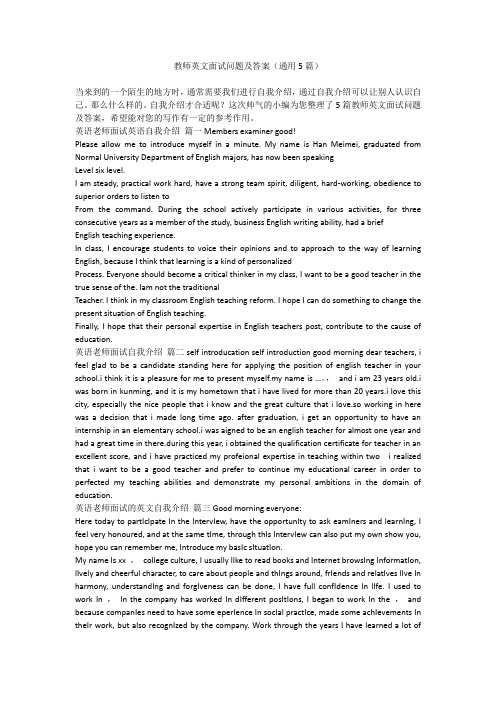
教师英文面试问题及答案(通用5篇)当来到的一个陌生的地方时,通常需要我们进行自我介绍,通过自我介绍可以让别人认识自己。
那么什么样的。
自我介绍才合适呢?这次帅气的小编为您整理了5篇教师英文面试问题及答案,希望能对您的写作有一定的参考作用。
英语老师面试英语自我介绍篇一Members examiner good!Please allow me to introduce myself in a minute. My name is Han Meimei, graduated from Normal University Department of English majors, has now been speakingLevel six level.I am steady, practical work hard, have a strong team spirit, diligent, hard-working, obedience to superior orders to listen toFrom the command. During the school actively participate in various activities, for three consecutive years as a member of the study, business English writing ability, had a briefEnglish teaching experience.In class, I encourage students to voice their opinions and to approach to the way of learning English, because I think that learning is a kind of personalizedProcess. Everyone should become a critical thinker in my class, I want to be a good teacher in the true sense of the. Iam not the traditionalTeacher. I think in my classroom English teaching reform. I hope I can do something to change the present situation of English teaching.Finally, I hope that their personal expertise in English teachers post, contribute to the cause of education.英语老师面试自我介绍篇二self introducation self introduction good morning dear teachers, i feel glad to be a candidate standing here for applying the position of english teacher in your school.i think it is a pleasure for me to present myself.my name is …。
2025年教师资格考试高级中学面试英语试题与参考答案
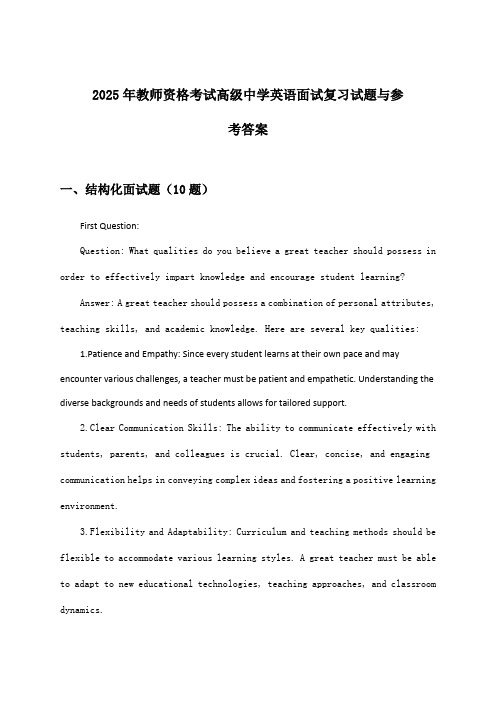
2025年教师资格考试高级中学英语面试复习试题与参考答案一、结构化面试题(10题)First Question:Question: What qualities do you believe a great teacher should possess in order to effectively impart knowledge and encourage student learning?Answer: A great teacher should possess a combination of personal attributes, teaching skills, and academic knowledge. Here are several key qualities:1.Patience and Empathy: Since every student learns at their own pace and may encounter various challenges, a teacher must be patient and empathetic. Understanding the diverse backgrounds and needs of students allows for tailored support.2.Clear Communication Skills: The ability to communicate effectively with students, parents, and colleagues is crucial. Clear, concise, and engaging communication helps in conveying complex ideas and fostering a positive learning environment.3.Flexibility and Adaptability: Curriculum and teaching methods should be flexible to accommodate various learning styles. A great teacher must be able to adapt to new educational technologies, teaching approaches, and classroom dynamics.4.Collaboration Skills: Working closely with colleagues and incorporating their insights can lead to more effective teaching strategies. Collaboration fosters a community of learners.5.Thorough Academic Knowledge: A deep understanding of subject matter is foundational. It enables a teacher to present material in a deeper and more insightful manner.6.Encouragement and Motivation: A great teacher can inspire and motivate students to pursue their educational and career goals. This involves recognizing and celebrating individual achievements and fostering a love for learning.7.Discipline and Organization: A structured classroom environment is essential for learning. A teacher must be well-organized, ensuring that lessons are carefully planned and resources are effectively utilized.8.Creativity and Innovation: Incorporating creative teaching methods can make learning more engaging and effective. Innovative strategies, such as project-based learning or interactive digital content, cater to the diverse needs of students.By embodying these qualities, a teacher can create a nurturing, stimulating, and effective classroom atmosphere conducive to learning and growth.解析:•引言和概述: 题目询问优秀教师应该具备哪些质量。
小学英语教师资格考试面试试题及解答参考(2025年)
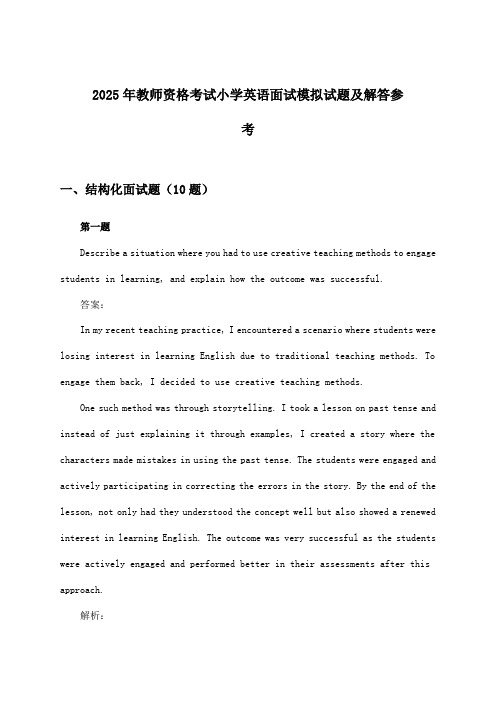
2025年教师资格考试小学英语面试模拟试题及解答参考一、结构化面试题(10题)第一题Describe a situation where you had to use creative teaching methods to engage students in learning, and explain how the outcome was successful.答案:In my recent teaching practice, I encountered a scenario where students were losing interest in learning English due to traditional teaching methods. To engage them back, I decided to use creative teaching methods.One such method was through storytelling. I took a lesson on past tense and instead of just explaining it through examples, I created a story where the characters made mistakes in using the past tense. The students were engaged and actively participating in correcting the errors in the story. By the end of the lesson, not only had they understood the concept well but also showed a renewed interest in learning English. The outcome was very successful as the students were actively engaged and performed better in their assessments after this approach.解析:这道题目考查了教师面对学生失去学习兴趣时,如何运用创造性的教学方法来吸引学生。
英语结构化面试试题和答案(含英文)

一、如何上好第一节课?注重仪表美,使学生感到你是位可亲的老师。
充分注重自己情感的发挥,在教学的每一个环节上都应包含“情”。
注重业务水平的发挥一一使学生感到你是位可信老师.给学生留下一个好的第一印象,建立良好的师生情感。
培养学生对本课程学习的兴趣利用“第一堂课”消除学生的自卑心理,树立自信心“第一节课”提出明确的要求、增强学生学习的自觉性除了正面引导、激发学生学习的主观能动性外。
还应对学生提出一些要求。
从客观上来促使学生认真学习.增强学生学习本课程的自觉性,如提出上课时必须认真听课、认真做笔记等要求。
Pay attention to the beauty of appearance, so that students feel you are a kind teacher. Fully pay attention to the exertion of their emotions,in every link of teaching should include "emotion”. Pay attention to the development of professional level to make students feel that you are a credible teacher. Make a good first impression on students, and establish good teacher—student emotions。
Develop students'interest in this courseUse ”the first lesson" to eliminate students’inferiority complex and build up self-confidence"The first lesson" puts forward clear requirements and enhances students'learning consciousnessIn addition to positively guiding and stimulating students’subjective initiative in learning。
2021年教师面试英文问题及答案

If I had a single flower for every time I think about you, I could walk forever in my garden.(WORD文档/A4打印/可编辑/页眉可删)教师面试英文问题及答案1、面试问题:你教了几年书?How long have you been teaching?回答:I have been teaching for...2、有教小学的经验吗?Did you have any experiences teaching in elementary school/primary school?回答:Yes, I did. or No, I didnt.3、你打算怎么样给小朋友上课?How are you going to give lessons to little kids?回答:I think I am going to use all kinds of materials that are available like CD player, pictures, word cards, TV, magazines, games ects in my lessons. I am going to use different teaching meathods to help children with different learning styles.4、能否示范一下?Can you demonstrate one lesson?回答:Sure. If I teach days of the week, I will teach children a song: Sunday, Monday...(用twinkle twinkle little star 的tune)5、你觉得教小学生跟教中学生有什么不同?What is the difference between teaching elementary school children and the junior high school children?回答:well, when teaching little kids a teacher has to be more help student learn Teaching junior high school kids is a little bit different. I can introduce some grammer. I can give them more written work and I can have more discussions with the children.英文面试问题及答案面试时本就容易紧张,英文面试更是愁坏不少同学,52个英文面试问题及答案,仔细研究保安心。
教师资格考试高级中学英语面试试题与参考答案
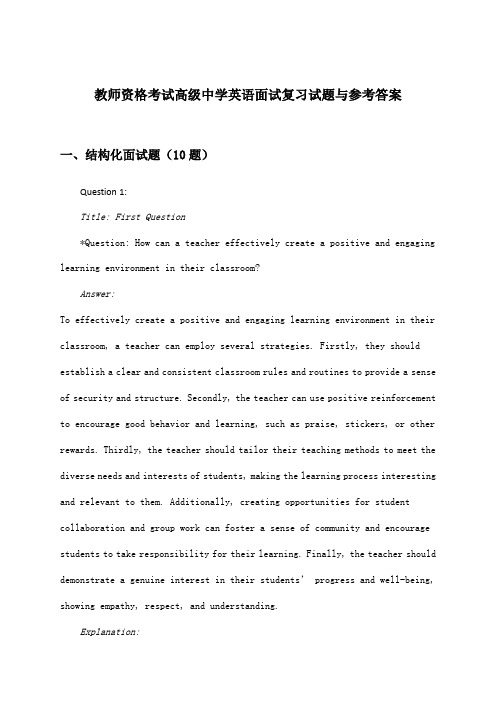
教师资格考试高级中学英语面试复习试题与参考答案一、结构化面试题(10题)Question 1:Title: First Question*Question: How can a teacher effectively create a positive and engaging learning environment in their classroom?Answer:To effectively create a positive and engaging learning environment in their classroom, a teacher can employ several strategies. Firstly, they should establish a clear and consistent classroom rules and routines to provide a sense of security and structure. Secondly, the teacher can use positive reinforcement to encourage good behavior and learning, such as praise, stickers, or other rewards. Thirdly, the teacher should tailor their teaching methods to meet the diverse needs and interests of students, making the learning process interesting and relevant to them. Additionally, creating opportunities for student collaboration and group work can foster a sense of community and encourage students to take responsibility for their learning. Finally, the teacher should demonstrate a genuine interest in their students’ progress and well-being, showing empathy, respect, and understanding.Explanation:Creating a positive and engaging learning environment is crucial for student success and motivation. A structured classroom with clear rules and routines helps students understand expectations and feel comfortable. Positive reinforcement, such as praise and rewards, boosts students’ confidence and encourages them to engage in learning activities. Tailoring teaching methods to meet diverse student needs ensures that all students feel included and motivated. Encouraging collaboration and group work helps students develop social skills and learn from each other. Lastly, demonstrating genuine interest in students’ well-being helps build strong relationships and creates a supportive learning atmosphere.第二题答案解析:本题要求考生描述一种有效的教学方法,并解释为什么这种方法对自己有帮助。
教师结构化面试试题答案(含英文翻译)

教师结构化面试试题答案(含英文翻译)work Information Technology Company.2020YEAR五十、伴随着网络的普及,“网络成瘾症”成为当前青少年一种新的精神疾病。
调查显示,我国青少年“网络成瘾症”的发病率高达15%。
假如你的邻居家的孩子是一个网瘾少年,你的邻居向你讨教。
你作为一名教师,会告诉他们哪些教育挽救网瘾少年的好办法?一是跟家长一起分析孩子上网成瘾的原因。
二是建议家长尊重孩子,不要采用训斥、打骂的教育方式。
三是建议家长注意跟孩子沟通谈心,多鼓励表扬,少指责埋怨。
四是建议家长创造温馨和睦的家庭关系,让孩子感受家的温暖和爸妈的疼爱。
五是建议家长疏堵结合,对孩子上网时间有所限制,引导孩子浏览健康有益的内容。
六是如果孩子上网已经成为比较严重的精神疾病,建议通过药物或请心理医生指导治疗。
One is to work with parents to analyze the causes of children's Internet addiction. Second, parents are advised to respect their children and not to adopt the educational methods of scolding and scolding. Third, parents are advised to pay attention to communicating with their children, encouraging praise more and blaming less. Fourth, parents are advised to create a warm and harmonious family relationship, so that children feel the warmth of home and the love of parents. Fifthly, parents should be advised to combine blocking, limit the time of children surfing the Internet, and guide children to browse healthy and beneficial content. Sixth, if the child's Internet access has become a more serious mental illness, it is recommended to use drugs or ask a psychiatrist to guide treatment.五十一、请你谈谈在当前多元化社会背景下,如何做好班主任工作。
- 1、下载文档前请自行甄别文档内容的完整性,平台不提供额外的编辑、内容补充、找答案等附加服务。
- 2、"仅部分预览"的文档,不可在线预览部分如存在完整性等问题,可反馈申请退款(可完整预览的文档不适用该条件!)。
- 3、如文档侵犯您的权益,请联系客服反馈,我们会尽快为您处理(人工客服工作时间:9:00-18:30)。
五十、伴随着网络的普及,“网络成瘾症”成为当前青少年一种新的精神疾病。
调查显示,我国青少年“网络成瘾症”的发病率高达 15%。
假如你的邻居家的孩子是一个网瘾少年,你的邻居向你讨教。
你作为一名教师,会告诉他们哪些教育挽救网瘾少年的好办法?一是跟家长一起分析孩子上网成瘾的原因。
二是建议家长尊重孩子,不要采用训斥、打骂的教育方式。
三是建议家长注意跟孩子沟通谈心,多鼓励表扬,少指责埋怨四是建议家长创造温馨和睦的家庭关系,让孩子感受家的温暖和爸妈的疼爱。
五是建议家长疏堵结合,对孩子上网时间有所限制,引导孩子浏览健康有益的内容。
六是如果孩子上网已经成为比较严重的精神疾病,建议通过药物或请心理医生指导治疗。
One is to work with parents to analyze the causes of children's Internet addiction. Second, parents are advised to respect their children and not to adopt the educational methods of scolding and scolding. Third, parents are advised to pay attention to communicating with their children, encouraging praise more and blaming less. Fourth, parents are advised to create a warm and harmonious family relationship, so that children feel the warmth of home and the love of parents. Fifthly, parents should be advised to combine blocking, limit the time of children surfing the Internet, and guide children to browse healthy and beneficial content. Sixth, if the child's Internet access has become a more serious mental illness, it is recommended to use drugs or ask a psychiatrist to guide treatment. 五十一、请你谈谈在当前多元化社会背景下,如何做好班主任工作。
①要发自内心的热爱本职工作,具有奉献精神。
②要有广博的学识,合理的知识结构和平和的心态③要善于引导班级舆论,建设健康向上的班级文化④要通权达变、会爱学生,精心呵护每个学生的心灵。
⑤要着力营造浓厚的学习氛围,注重学生自主学习能力的培养。
⑥要掌握与家长沟通的技巧,把学校教育与家庭教育有机结合起来。
First, we should love our work from the heart and have the spirit of dedication.Second, we should have broad knowledge, reasonable knowledge structure and a peaceful mind.Third, we should be good at guiding class public opinion and building a healthyand upward class culture.Fourthly, we should be flexible, love students and carefully care for each student's soul.We should strive to create a strong learning atmosphere and pay attention tothe cultivation of students'autonomous learning ability.We should master the skills of communicating with parents and combine school education with family education.四十五、即将要走上讲台的你,自我感觉对教师这一职业,最大的优势和最大的不足分别是什么?(结合下一题回答)随着新课程改革的不断推进,教育需要新鲜血液的注入。
新教师做为年轻人,易于接受新事物,容易与学生沟通,更快进入新课改的教师角色。
A.我个人来说,我是师范毕业,在心理上一致认为自己是一名准教师,不要小看这样的心理,这是非常重要的,我经常会看一些跟教育教学有关的书和文章,并有了写教育日志的习惯,不断补充着自己的教育细胞。
B.我一直有意提高自己的教学能力,利用假期带家教,并进行了一个多月的教学实习,从事教育事业不会觉得陌生。
C.我积极向上,善良,正直,细心并且有耐心,最重要的是我真心的喜欢学生,喜欢跟他们在一起,教给他们知识,陪伴他们成长。
当然,作为一名新人,我有很多的不足,缺乏经验,年轻气盛,面对突发问题,不如老教师考虑周全。
但是,我相信,只要我努力,不久的将来我就能成为一名优秀的老师四十六、年轻教师有什么优势和劣势?优势:一是思维活泼,很容易和孩子打成一片。
二是有正确的教育思想,热爱自己从事的事业,对待教学工作有强烈的责任感,爱自己的每个学生。
三是能以发展的眼光要求自己,坚持继续教育。
四是具备良好的思想道德素养和心理素质,有广泛的兴趣、稳定的情绪、坚强的意识、活泼开朗的个性。
五是谦虚、积极要求上进,能认真听取有经验的老师的指导与建议。
六是能运用多媒体手段丰富课堂教学。
劣势:一是缺乏经验。
二是缺乏耐心,三是作为一个新教师,对于课堂教学,如何使教学效果最优化、最大化,这还是一个不断学习和摸索的过程。
四是有时在处理人际关系上显得不够老练。
五是有些理论与实际操作脱节。
六是有反思但不深入,缺乏教学经验。
Advantages:First, the thinking is lively and easy to integrate with children. Secondly, we should have correct educational thoughts, love our own career, have a strong sense of responsibility for teaching, and love every student of our own. Thirdly, we should insist on continuing education from the perspective of development. Fourth, they have good ideological, moral and psychological qualities, broad interests, stable emotions, strong consciousness and lively and cheerful personality. Fifth, be modest and positive, and be able to listen carefully to the guidance and suggestions of experienced teachers. Sixth, we can enrich classroom teaching by means of multimedia.Inferiority:One is lack of experience. Second, lack of patience. Third, as a new teacher, how to optimize and maximize the effect of classroom teaching is still a process of continuous learning and exploration. Fourthly, sometimes they are not sophisticated enough in dealing with interpersonal relationships. Fifth, there are some disconnections between theory and practice. Sixth, there is reflection but not in-depth, lack of teaching experience. 四十七、请你列举新课程改革倡导的学习方式,并就每一种学习方式加以简单说明。
【答案要点】新课程改革倡导自主学习、合作学习和探究学习的学习方式。
自主学习就是“学生自我导向、自我激励、自我监控”的高质量的学习。
合作学习是指学生在小组或团队中为了完成共同的任务,有明确责任分工的互助性学习。
探究学习是从学科领域或现实生活中选择和确定研究主题,在教学中创设一种类似于学术(或科学)研究的情境,学生通过实验、操作、调查、信息搜集与处理、表达与交流等探索活动,自主地、独立地发现问题、获得知识、技能,发展情感与态度,特别是探索精神和创新能力。
The new curriculum reform advocates independent learning, cooperative learning and inquiry learning.Self-regulated learning is a kind of high-quality learning characterized by students'self-orientation, self-motivation and self-monitoring.Cooperative learning refers to the mutually-assisted learning in which students have clear responsibilities and division of labor in order to accomplish common tasks in groups or teams.Inquiry learning chooses and determines research topics from the field of disciplines or real life. It creates a situation similar to academic (or scientific) research in teaching. Students discover problems independently and independently, acquire knowledge and skills, develop emotions and attitudes, especially exploratory spirit, through exploratory activities such as experiments, operations, surveys, information collection and processing, expression and communication. Ability to innovate.四十八、请你谈谈在当前信息化社会中,一个优秀教师应该具备哪些素质。
